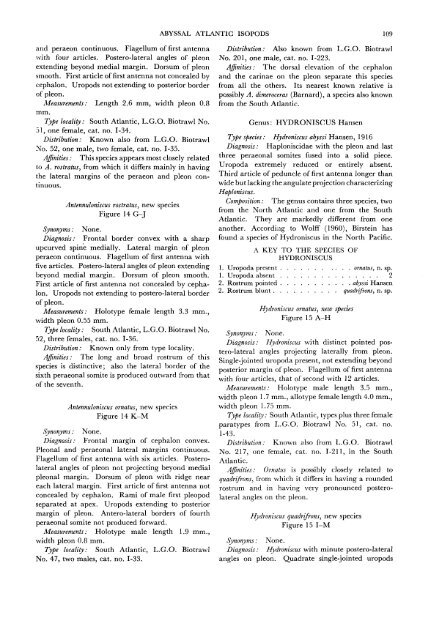The Isopods of Abyssal Depths in the Atlantic Ocean
The Isopods of Abyssal Depths in the Atlantic Ocean
The Isopods of Abyssal Depths in the Atlantic Ocean
Create successful ePaper yourself
Turn your PDF publications into a flip-book with our unique Google optimized e-Paper software.
and peraeon cont<strong>in</strong>uous. Flagellum <strong>of</strong> first antenna<br />
with four articles. Postero-lateral angles <strong>of</strong> pleon<br />
extend<strong>in</strong>g beyond medial marg<strong>in</strong>. Dorsum <strong>of</strong> pleon<br />
smooth. First article <strong>of</strong> first antenna not concealed by<br />
cephalon. Uropods not extend<strong>in</strong>g to posterior border<br />
<strong>of</strong> pleon.<br />
Measurements: Length 2.6 mm, width pleon 0.8<br />
mm.<br />
Type locality: South <strong>Atlantic</strong>, L.G.O. Biotrawl No.<br />
51, one female, cat. no. 1-34.<br />
Distribution: Known also from L.G.O. Biotrawl<br />
No. 52, one male, two female, cat. no. 1-35.<br />
Aff<strong>in</strong>ities: This species appears most closely related<br />
to A. rostratus, from which it differs ma<strong>in</strong>ly <strong>in</strong> hav<strong>in</strong>g<br />
<strong>the</strong> lateral marg<strong>in</strong>s <strong>of</strong> <strong>the</strong> peraeon and pleon cont<strong>in</strong>uous.<br />
Antennuloniscus rostratus, new species<br />
Figure 14 G-J<br />
Synonyms: None.<br />
Diagnosis: Frontal border convex with a sharp<br />
upcurved sp<strong>in</strong>e medially. Lateral marg<strong>in</strong> <strong>of</strong> pleon<br />
peraeon cont<strong>in</strong>uous. Flagellum <strong>of</strong> first antenna with<br />
five articles. Postero-lateral angles <strong>of</strong> pleon extend<strong>in</strong>g<br />
beyond medial marg<strong>in</strong>. Dorsum <strong>of</strong> pleon smooth.<br />
First article <strong>of</strong> first antenna not concealed by cephalon.<br />
Uropods not extend<strong>in</strong>g to postero-lateral border<br />
<strong>of</strong> pleon.<br />
Measurements: Holotype female length 3.3 mm.,<br />
width pleon 0.55 mm.<br />
Type locality: South <strong>Atlantic</strong>, L.G.O. Biotrawl No.<br />
52, three females, cat. no. 1-36.<br />
Distribution: Known only from type locality.<br />
Aff<strong>in</strong>ities: <strong>The</strong> long and broad rostrum <strong>of</strong> this<br />
species is dist<strong>in</strong>ctive; also <strong>the</strong> lateral border <strong>of</strong> <strong>the</strong><br />
sixth peraeonal somite is produced outward from that<br />
<strong>of</strong> <strong>the</strong> seventh.<br />
Antennuloniscus ornatus, new species<br />
Figure 14 K-M<br />
Synonyms: None.<br />
Diagnosis: Frontal marg<strong>in</strong> <strong>of</strong> cephalon convex.<br />
Pleonal and peraeonal lateral marg<strong>in</strong>s cont<strong>in</strong>uous.<br />
Flagellum <strong>of</strong> first antenna with six articles. Posterolateral<br />
angles <strong>of</strong> pleon not project<strong>in</strong>g beyond medial<br />
pleonal marg<strong>in</strong>. Dorsum <strong>of</strong> pleon with ridge near<br />
each lateral marg<strong>in</strong>. First article <strong>of</strong> first antenna not<br />
concealed by cephalon. Rami <strong>of</strong> male first pleopod<br />
separated at apex. Uropods extend<strong>in</strong>g to posterior<br />
marg<strong>in</strong> <strong>of</strong> pleon. Antero-lateral borders <strong>of</strong> fourth<br />
peraeonal somite not produced forward.<br />
Measurements: Holotype male length 1.9 mm.,<br />
width pleon 0.8 mm.<br />
Type locality: South <strong>Atlantic</strong>, L.G.O. Biotrawl<br />
No. 47, two males, cat. no. 1-33.<br />
ABYSSAL ATLANTIC ISOPODS 109<br />
Distribution: Also known from L.G.O. Biotrawl<br />
No. 201, one male, cat. no. 1-223.<br />
Aff<strong>in</strong>ities: <strong>The</strong> dorsal elevation <strong>of</strong> <strong>the</strong> cephalon<br />
and <strong>the</strong> car<strong>in</strong>ae on <strong>the</strong> pleon separate this species<br />
from all <strong>the</strong> o<strong>the</strong>rs. Its nearest known relative is<br />
possibly A. dimeroceras (Barnard), a species also known<br />
from <strong>the</strong> South <strong>Atlantic</strong>.<br />
Genus: HYDRONISCUS Hansen<br />
Type species: Hydroniscus abyssiHansen, 1916<br />
Diagnosis: Haploniscidae with <strong>the</strong> pleon and last<br />
three peraeonal somites fused <strong>in</strong>to a solid piece.<br />
Uropoda extremely reduced or entirely absent.<br />
Third article <strong>of</strong> peduncle <strong>of</strong> first antenna longer than<br />
wide but lack<strong>in</strong>g <strong>the</strong> angulate projection characteriz<strong>in</strong>g<br />
Haploniscus.<br />
Composition: <strong>The</strong> genus conta<strong>in</strong>s three species, two<br />
from <strong>the</strong> North <strong>Atlantic</strong> and one from <strong>the</strong> South<br />
<strong>Atlantic</strong>. <strong>The</strong>y are markedly different from one<br />
ano<strong>the</strong>r. Accord<strong>in</strong>g to Wolff (1960), Birste<strong>in</strong> has<br />
found a species <strong>of</strong> Hydroniscus <strong>in</strong> <strong>the</strong> North Pacific.<br />
A KEY TO THE SPECIES OF<br />
HYDRONISCUS<br />
1. Uropoda present ornatus, n. sp.<br />
1. Uropoda absent 2<br />
2. Rostrum po<strong>in</strong>ted abyssi Hansen<br />
2. Rostrum blunt guadrifrons, n. sp.<br />
Hydroniscus ornatus, new species<br />
Figure 15 A-H<br />
Synonyms: None.<br />
Diagnosis: Hydroniscus with dist<strong>in</strong>ct po<strong>in</strong>ted postero-lateral<br />
angles project<strong>in</strong>g laterally from pleon.<br />
S<strong>in</strong>gle-jo<strong>in</strong>ted uropoda present, not extend<strong>in</strong>g beyond<br />
posterior marg<strong>in</strong> <strong>of</strong> pleon. Flagellum <strong>of</strong> first antenna<br />
with four articles, that <strong>of</strong> second with 12 articles.<br />
Measurements: Holotype male length 3.5 mm.,<br />
width pleon 1.7 mm., allotype female length 4.0 mm.,<br />
width pleon 1.75 mm.<br />
Type locality: South <strong>Atlantic</strong>, types plus three female<br />
paratypes from L.G.O. Biotrawl No. 51, cat. no.<br />
1-43.<br />
Distribution: Known also from L.G.O. Biotrawl<br />
No. 217, one female, cat. no. 1-211, <strong>in</strong> <strong>the</strong> South<br />
<strong>Atlantic</strong>.<br />
Aff<strong>in</strong>ities: Ornatus is possibly closely related to<br />
guadrifrons, from which it differs <strong>in</strong> hav<strong>in</strong>g a rounded<br />
rostrum and <strong>in</strong> hav<strong>in</strong>g very pronounced posterolateral<br />
angles on <strong>the</strong> pleon.<br />
Hydroniscus quadrifrons, new species<br />
Figure 15 I-M<br />
Synonyms: None.<br />
Diagnosis: Hydroniscus with m<strong>in</strong>ute postero-lateral<br />
angles on pleon. Quadrate s<strong>in</strong>gle-jo<strong>in</strong>ted uropods

















